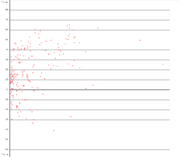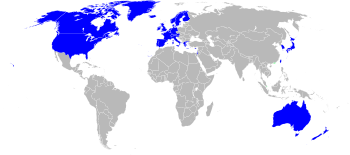- North–South divide
-
This article is about the global north–south divide. For the divide in the UK, see North–south divide in the United Kingdom. For the historical divide in the United States, see Mason-Dixon Line.
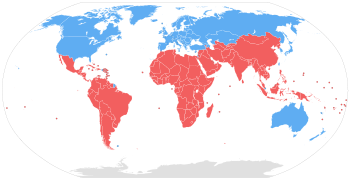 The updated view of the north–south divide. Blue includes G8 states and developed/ first world states.
The updated view of the north–south divide. Blue includes G8 states and developed/ first world states.
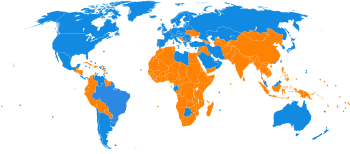 World map showing countries above and below the world GDP (PPP) per capita, currently $10,700. Source: IMF (International Monetary Fund).
World map showing countries above and below the world GDP (PPP) per capita, currently $10,700. Source: IMF (International Monetary Fund).
Blue above world GDP (PPP) per capita
Orange below world GDP (PPP) per capita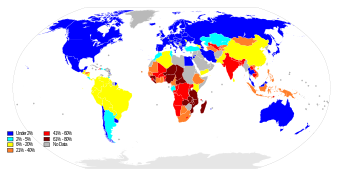 Map of world poverty by country, showing percentage of population living on less than $1.25 per day. Unfortunately, information is missing for some countries.
Map of world poverty by country, showing percentage of population living on less than $1.25 per day. Unfortunately, information is missing for some countries.
The north–south divide is a socio-economic and political division that exists between the wealthy developed countries, known collectively as "the north", and the poorer developing countries (least developed countries), or "the south."[1] Although most nations comprising the "North" are in fact located in the Northern Hemisphere (with the notable exceptions of Australia and New Zealand), the divide is not wholly defined by geography. The North is home to four of the five permanent members of the United Nations Security Council and all members of the G8. "The North" mostly covers the West and the First World, with much of the Second World. The expression "north–south divide" is still in common use, but the terms "North" and "South" are already somewhat outdated. As nations become economically developed, they may become part of the "North", regardless of geographical location, while any other nations which do not qualify for "developed" status are in effect deemed to be part of the "South."[2]
Contents
History
The idea of categorizing countries by their economic and developmental status began during the Cold War with the classifications of East and West. The Soviet Union and China represented the developing East, and the United States and their allies represented the more developed West. Out of this paradigm of development surged the division of the First World [the west] and the Second World [the east] with the even less developed countries constituting the Third World. As some Second World countries joined the First World, and others joined the Third World, a new and simpler classification was needed. The First World became the “North” and the Third World became the “South”. [3]
Problems with defining the divide
Following the fall of the Soviet Bloc, which was commonly referred to as the Second World, many of its constituent countries were reclassified as developing, despite being geographically northern. At the same time, geographically southern nations previously considered "developing," such as the East Asian Tigers or Turkey, have joined the modern First World, but are classified inconsistently in maps showing the north–south divide.[citation needed] Similarly, dependencies of developed nations are also classified as Southern, although they are part of the developed world.[4]
On an ideological level, some development geographers have argued that current concentration on the north–south divide as the main organizing principle for understanding the world economy has overlooked the role of inter-imperial conflicts between the United States, Japan, and Europe.[5]
Defining development
Being categorized as part of the “North” implies development as opposed to belonging to the “South” which implies a lack thereof. The north becomes synonymous with economic development and industrialization while the South represents the previously colonized countries which are in need of help in the form of international aid agendas [6] In order to understand how this divide occurs, a definition of “development” itself is needed.
The Dictionary of Human Geography defines development as “[p]rocesses of social change or [a change] to class and state projects to transform national economies".[7] This definition entails an understanding of economic development which is imperative when trying to understand the north–south divide.
Economic Development is a measure of progress in a specific economy. It refers to advancements in technology, a transition from an economy based largely on agriculture to one based on industry and an improvement in living standards.[8][9]
Other factors that are included in the conceptualization of what a developed country is include life expectancy and the levels of education, poverty and employment in that country.
The north
Organisations such as the World Bank, the International Monetary Fund (IMF) and the Central Intelligence Agency (CIA), generally agree that the group of developed countries includes the following countries/regions:[citation needed]
Americas
 Bermuda (UK Territory)
Bermuda (UK Territory) Canada
Canada United States
United States
Asia
- Special Administrative Region of the People's Republic of China:
 Israel
Israel Japan
Japan Singapore
Singapore South Korea
South Korea Taiwan
Taiwan
European Union and European Free Trade Association
Oceania
Brandt Line
The Brandt Line is a visual depiction of the north–south divide, proposed by German Chancellor Willy Brandt in the 1980s. It approximately encircles the world at a latitude of 30° N, passing between North and Central America, north of Africa and the Middle East, climbing north over China, Mongolia and Korea, but dipping south so as to include Australia and New Zealand in the "Rich North".
Digital divide
The global digital divide is often characterised as corresponding to the north–south divide; however, Internet use, and especially broadband access, is now soaring in Asia compared with other continents. This phenomenon is partially explained by the ability of many countries in Asia to bypass older Internet technology and infrastructure, coupled with booming economies which allow vastly more people to get online.
Development gap
The north–south divide has more recently been named the development continuum gap. This places greater emphasis on closing the evident gap between rich (more economically developed) and poor (less economically developed) countries. A good measure of on which side of the gap a country is located is the Human Development Index (HDI). The nearer this is to 1.0, the greater is the country's level of development and the further the country is on its development pathway (closer towards being well developed), exemplified well by Walter Rostow's model of development and the Clark Fisher model.[citation needed]
Theories explaining the divide
Capitalism
Capitalism leads to inequality: the capitalist ideology relies on the constant motivation to produce capital accumulation. The nature of capitalism leads those countries with a comparative advantage (developed) to accumulate capital through dispossession or in other words to take capital from those less advantaged (un-developed/developing). This accumulation by dispossession leads to the unequal development that feeds the north–south divide.[10]
Globalization
Globalization, or Global Capitalism, as the leading cause for global inequality: globalization enhances social and economic gaps between countries, since it requires economies and societies to adapt in a very rapid manner, and because this almost never happens in an equal fashion, some nations grow faster than others. Rich countries exploit poorer countries to a point where developing countries become dependent on developed countries for survival. The very structure and process of globalization perpetuates and reproduces unequal relationships and opportunities between the North and the South, it tends to "favor the privileged and further marginalize the already disadvantaged".[11]
Immigration
Uneven immigration patterns lead to inequality: in the late eighteenth and nineteenth centuries immigration was very common into areas previously less populated (North America, Australia, New Zealand) from already technologically advanced areas (United Kingdom, Spain, Portugal). This facilitated an uneven diffusion of technological practices since only areas with high immigration levels benefited. Immigration patterns in the twenty-first century continue to feed this uneven distribution of technological innovation. People are eager to leave countries in the South in attempts to better their life standards and get their share in the prosperity of the North. “South and Central Americans want to live and work in North America. Africans and Southwest Asians want to live and work in Europe. Asians want to live and work in North America and Europe”.[3]
Closing the divide
Some would argue that free international trade and unhindered capital flows across countries will lead to a contraction in the North-South divide. In this case more equal trade and flow of capital would allow the possibility for developing countries to further develop economically.[3] As some countries in the South experience rapid development, there is some evidence that those states are developing high levels of South-South aid.[12] Brazil, in particular, has been noted for its high levels of aid ($1 billion annually - ahead of many traditional donors) and the ability to use its own experiences to provide high levels of expertise and knowledge transfer.[12] This has been described as a 'global model in waiting'.[13]
The United Nations has also established its role in diminishing the divide between North and South through its Millennium Development Goals . These goals seek to eradicate extreme poverty and hunger; achieve universal primary education; promote gender equality and empower women; reduce child mortality; improve maternal health; combat HIV/AIDS, malaria and other diseases; ensure environmental sustainability; and develop a global partnership for development all by the year 2015.[14]
See also
- South-South Cooperation
- Third World
- Non-Aligned Movement
- Geopolitics
- North-South divide in Belgium
- North–south divide in England
- North–south divide in Italy
- North–south divide in Korea
- North–south divide in the United States
- North–south divide in Wales
References
- ^ S-Cool! - GCSE Geography Revision - Quicklearn
- ^ North–South divide
- ^ a b c Reuveny, Rafael X. “The North–South Divide and International Studies: A Symposium.” International Studies Review 9.4 (2007): 556-564. Academic Search complete. EBSCO. Web. 23 Oct. 2009. <http://web.ebscohost.com/ehost/pdf?vid=2&hid=12&sid=0e1fde42-af75-45ea-bd90-bdf571d6ea2a%40sessionmgr10>
- ^ Therien. J.P, (1999) Beyond the north–south divide: the two tales of world poverty. Third World Quarterly. Vol 20. No. 4. pp723-742
- ^ Corbridge, S., (1986), Capitalist World Development. MacMillian, see esp. sec. 5.3
- ^ Preece, Julia. "Lifelong learning and development: a perspective from the ‘South’" Compare: A Journal of Comparative and International Education 39.5 (2009). 23 Oct. 2009.<http://www.informaworld.com/10.1080/03057920903125602>
- ^ Gregory, Derek, Ron Johnston, Geraldine Pratt , Michael J. Watts, and Sarah Whatmore. The Dictionary of Human Geography. 5th. Wiley-Blackwell , 2009. Print.
- ^ Economic development “implies progressive changes in the socio-economic structure of a country […] [a] change in technological and institutional organization of production as well as in distributive pattern of income”
- ^ http://www.economics4development.com/
- ^ Harvey, David. Notes towards a theory of uneven geographical development
- ^ Kacowicz, Arie M. "Globalization, Poverty, and the North–South Divide." International Studies Review 9.4 (2007): 565-580. Academic Search Complete. EBSCO. Web. 23 Oct. 2009. <http://web.ebscohost.com/ehost/pdf?vid=1&hid=12&sid=367df3b7-0f9b-4e9e-b30c-8d4044a4d932%40sessionmgr10>
- ^ a b Cabral and Weinstock 2010. Brazil: an emerging aid player. London: Overseas Development Institute
- ^ Cabral, Lidia 2010. Brazil’s development cooperation with the South: a global model in waiting. London: Overseas Development Institute
- ^ http://www.un.org/millenniumgoals/
External links
- Share The World's Resources: The Brandt Commission Report, a 1980 report by a commission led by Willy Brandt that popularized the terminology
- Brandt 21 Forum, a recreation of the original commission with an updated report (information on original commission at site)
South-South cooperation and Third Worldism The Third World Emerging markets · Emerging Markets Index · Newly industrialized country · Landlocked developing countries · ACP countries · Least Developed Countries · Heavily Indebted Poor Countries · Fourth WorldOrganizations G-77 · G-15 · G-20 · G-24 · G-33 · G-11 · G90 · ASEAN · SAARC · African Union · Melanesian Spearhead Group · Polynesian Leaders Group · United Nations Industrial Development Organization · UNDP · United Nations Conference on Trade and Development · Arab Monetary Fund · Asian Clearing Union · Asian Development Bank · Bank of the South · South Centre · Third World NetworkGeopolitics Decolonization · Neocolonialism · Third World debt · Cold War · IBSA · BASIC · BRIC · Next Eleven · Global digital divide · Flying Geese Paradigm · World Conference against Racism · Durban Review Conference · Fair tradeCategories:- Economic geography
- Demographics
- Country classifications
Wikimedia Foundation. 2010.

